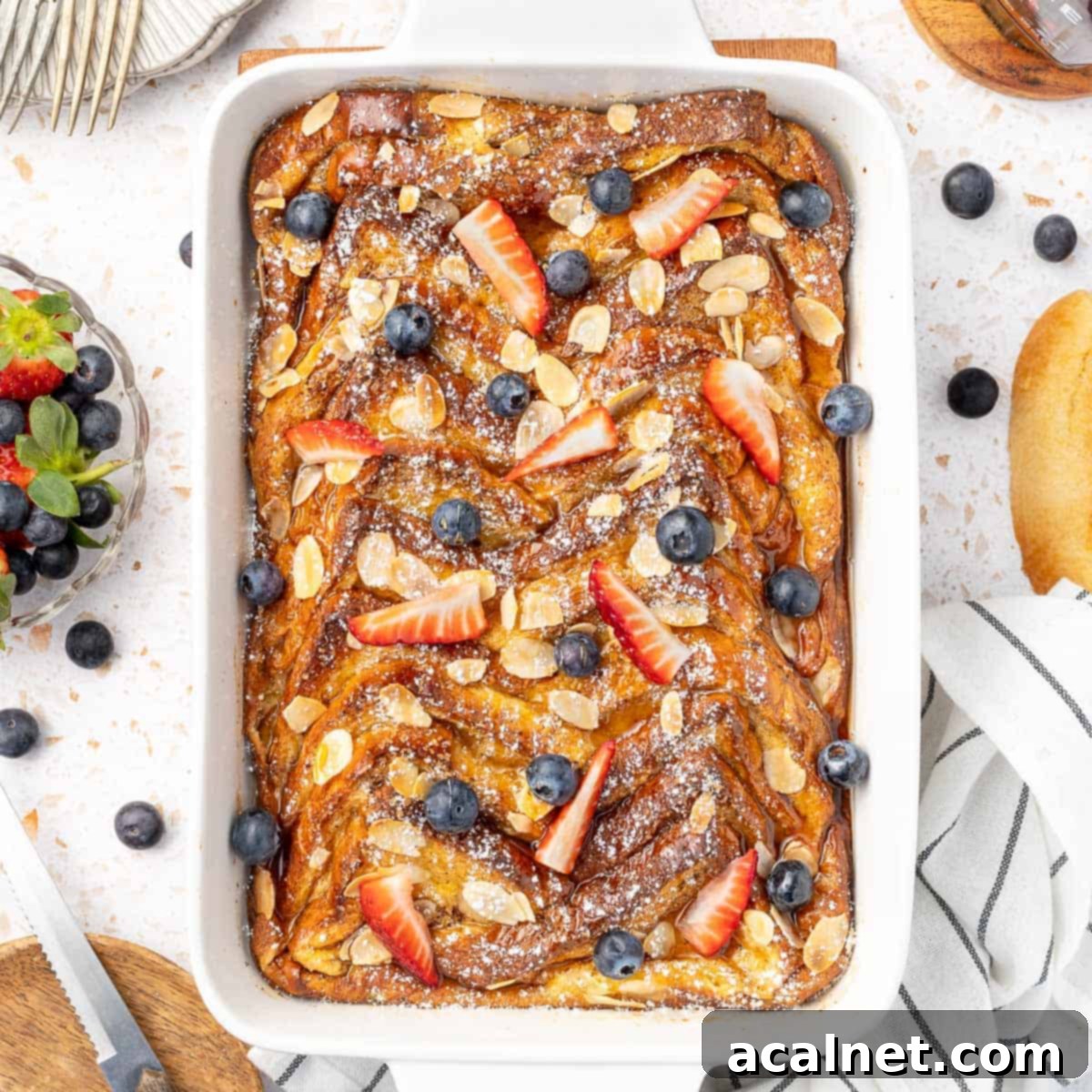Decadent Brioche French Toast Casserole: Your Ultimate Easy & Make-Ahead Brunch Bake
This super easy Brioche French Toast Casserole Bake transforms simple ingredients into the most delicious and decadent breakfast or brunch dish imaginable. It’s the perfect recipe to serve for a special occasion, host a memorable holiday breakfast, or simply gather your family for a truly delightful morning meal. Imagine golden-brown brioche, soft on the inside and caramelized on top, steeped in a rich, spiced custard – all baked effortlessly in one dish. This casserole is not just a meal; it’s an experience, designed to bring joy and warmth to your table with minimal fuss.
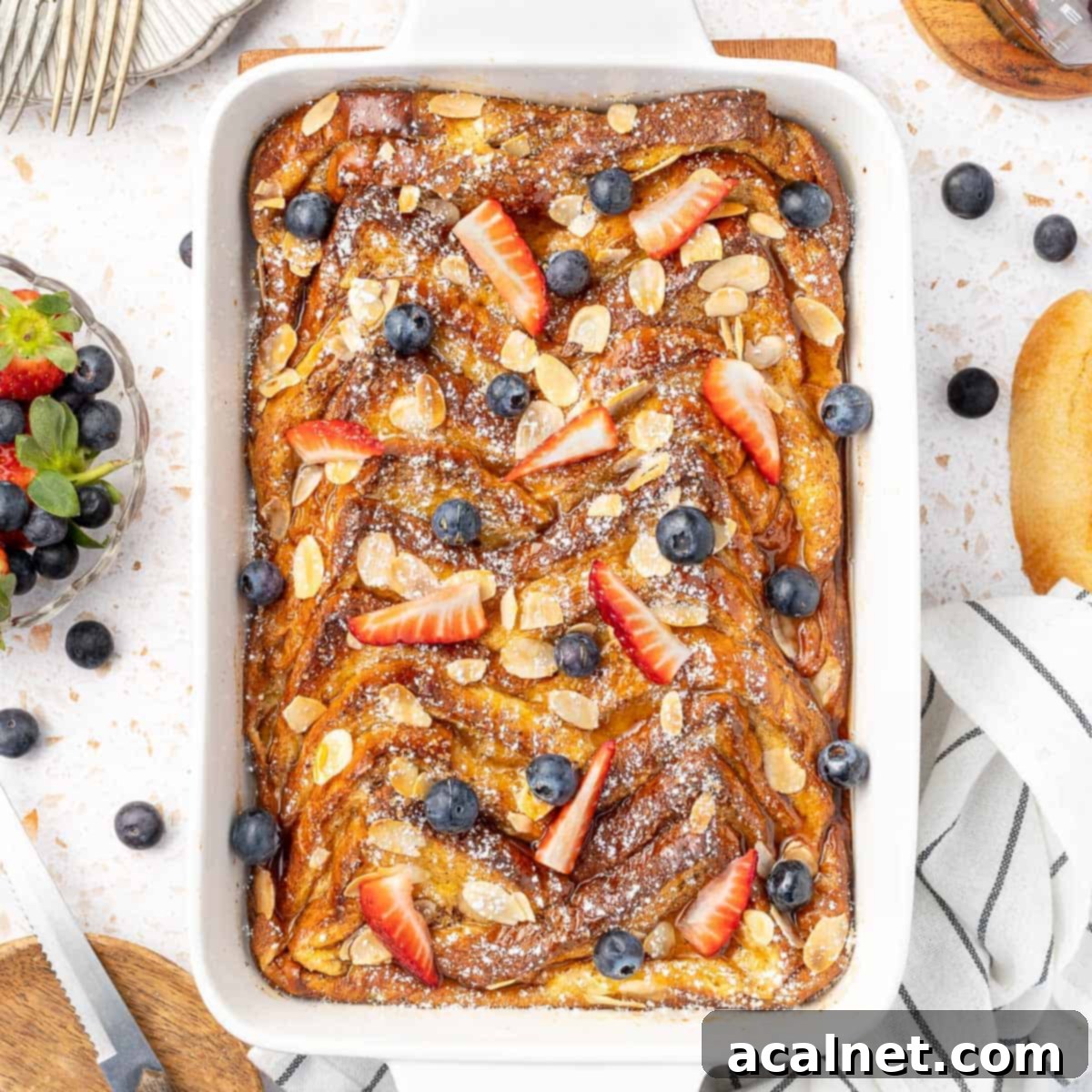
[feast_advanced_jump_to]
Why You’ll Adore This Brioche French Toast Casserole
This Baked French Toast Casserole isn’t just a recipe; it’s a breakfast revelation. What makes it so utterly irresistible? Let’s dive in:
- Unmatched Texture and Flavor: At the heart of this dish is rich, buttery brioche bread. Just like in my beloved Brioche Bread French Toast, the brioche’s inherent sweetness and tender crumb absorb the creamy custard beautifully. When baked, the bottom becomes incredibly soft and custardy, while the top crisps up to a deliciously golden, caramelized perfection. It’s a delightful contrast in every bite.
- Effortlessly Elegant: Despite its luxurious taste, this French toast bake is surprisingly easy to make with just a few basic ingredients. It requires minimal active prep time, making it an ideal choice for a special breakfast or brunch without stressing over complex steps.
- Perfect for Any Celebration: This brioche casserole shines on festive occasions like Thanksgiving, Christmas morning, or Easter brunch. It feeds a crowd beautifully and can even be prepared in advance, allowing you to enjoy precious moments with family and friends instead of being stuck in the kitchen.
- Customizable Decadence: While divine on its own, this recipe is a fantastic canvas for creativity. Elevate it further by making your own Brioche Loaf Bread from scratch. For an even more decadent twist, consider replacing the classic brioche with my indulgent Chocolate Swirl Brioche or the delightful Chocolate Chip Brioche. The possibilities are endless!
- A Crowd-Pleaser: Everyone loves French toast, and turning it into a casserole makes it communal and easy to serve. It’s a comforting dish that evokes childhood memories and creates new ones, making it a guaranteed hit with guests of all ages.
If you’re a fan of baked French toast, you’ll also love my Croissant French Toast Bake for another buttery, flaky twist on a classic!
Essential Ingredients for Your Brioche French Toast Casserole
Crafting the perfect Brioche French Toast Casserole requires a thoughtful selection of ingredients. Each component plays a crucial role in achieving that sought-after balance of rich flavor, tender texture, and irresistible aroma. Here’s a closer look at what you’ll need and why:
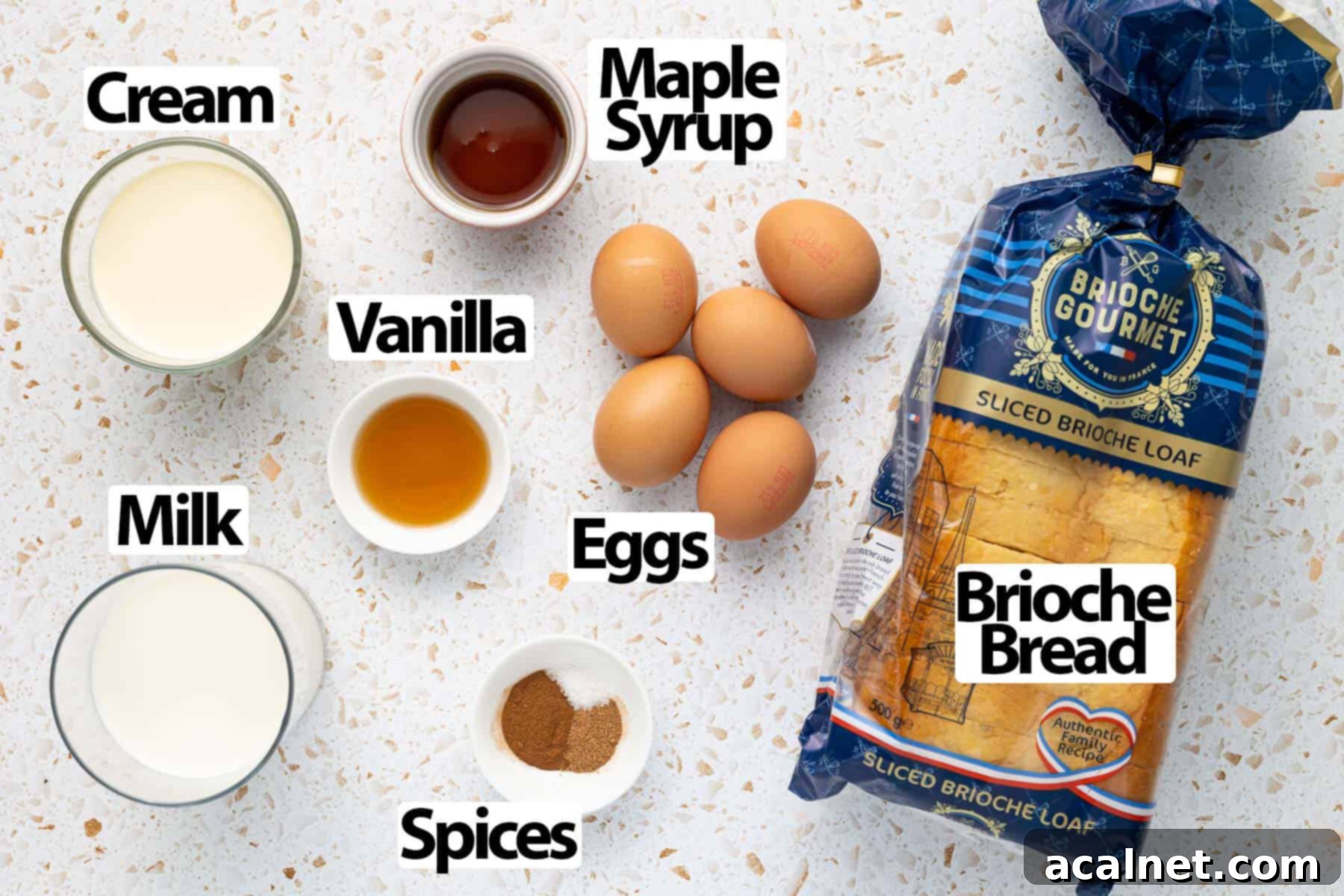
Scroll down to the recipe card below for all exact quantities and measurements.
- Brioche Bread: This is the star of the show! For the most authentic and delicious result, always opt for pure butter brioche. While store-bought brioche offers great convenience and works perfectly, you can elevate your casserole by making your own Brioche Loaf. The slight staleness of the bread (day-old is ideal) is key as it allows the brioche to soak up the custard without becoming mushy. If you’re not using pre-sliced brioche, make sure to cut your loaf into thick slices, at least 1.5 cm (0.6-inch) wide, to ensure they hold their shape and texture during baking.
- Cream & Milk: A luxurious combination of Thickened / Heavy Cream and Full Cream / Whole Milk forms the rich base of our custard. This duo provides the luscious texture and decadent flavor that defines this casserole. It’s crucial not to use low-fat cream or milk here; the fat content is essential for that coveted richness in the custard. You can experiment with the ratio of cream to milk to adjust the richness to your preference – more milk for a slightly lighter casserole, more cream for ultimate indulgence.
- Eggs: Large eggs are vital for creating a custardy texture and binding all the ingredients together. They provide structure and contribute significantly to the rich flavor profile.
- Maple Syrup: Unlike many French toast recipes that rely on caster or brown sugar, this recipe uses pure maple syrup for a more nuanced, natural sweetness and a hint of warm, woodsy flavor. Maple syrup is a natural pairing with French toast, infusing the custard with its signature taste. You can substitute it with honey or another natural sweetener if preferred. The recipe is designed to be moderately sweet, but feel free to increase the quantity if you desire a sweeter dish.
- Vanilla Extract: A touch of pure vanilla extract enhances all the other flavors, adding a comforting, aromatic depth to the custard. Don’t skip this ingredient; it makes a noticeable difference.
- Spices: A pinch of Salt, a generous dash of Cinnamon, and a hint of Nutmeg are the warming spices that truly bring this dish to life. While the nutmeg is optional, these spices complement the brioche and maple syrup beautifully, creating a cozy and inviting aroma as it bakes. They are crucial for that classic French toast taste.
For an extra layer of texture and visual appeal, I love topping the french toast with some Flaked Almonds and Raw Sugar before baking. The almonds add a delightful crunch, and the raw sugar caramelizes into a glittering, sweet crust. These toppings are entirely optional but highly recommended for an elevated experience.
Flavour Variation: Personalizing Your Casserole
This recipe serves as a versatile foundation, ready to be customized with your favorite additions. You can incorporate extra ingredients either before baking or as a final flourish before serving:
- For a Fruity Twist: Add fresh or frozen berries (blueberries, raspberries, sliced strawberries) directly into the casserole before baking, or sprinkle fresh ones on top just before serving. Sliced bananas or peaches also work wonderfully.
- Chocoholic’s Dream: Stir in a handful of chocolate chips (dark, milk, or white) into the custard mixture or scatter them over the brioche layers before baking. They’ll melt into luscious pockets of chocolatey goodness.
- Nutty Crunch: Incorporate chopped nuts like pecans, walnuts, or hazelnuts for added texture and earthy flavor. These can be mixed into the custard or sprinkled on top with the flaked almonds.
- Citrus Brightness: A little lemon or orange zest in the custard can add a vibrant, fresh note that cuts through the richness.
- Seasonal Spice: During the holidays, consider adding a pinch of ground ginger or cardamom for an extra festive touch.
How to Make This Irresistible Brioche French Toast Bake
Creating this delicious Brioche French Toast Casserole is a straightforward process that yields impressive results. Follow these simple steps to bring this comforting breakfast to life:
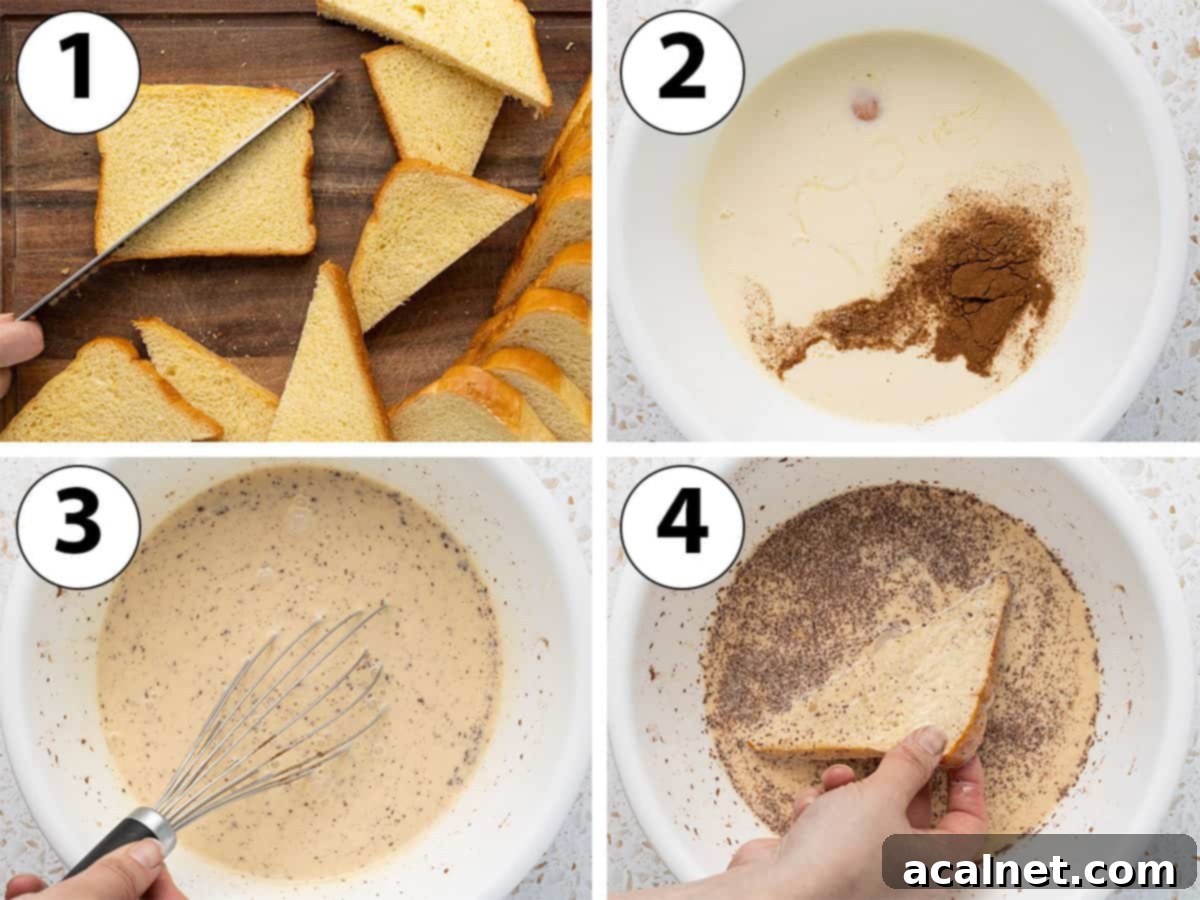
Here are the step-by-step instructions to create this delightful Brioche French Toast Casserole:
- Prepare Your Baking Dish: Start by lightly greasing a 21 x 29 cm (8 x 11 inch) ceramic baking dish with butter or oil. This ensures your French toast casserole won’t stick and will release easily. A slightly larger dish will also work if you prefer thinner slices or a less dense casserole.
- Slice the Brioche: If you’re using a full loaf of brioche, carefully cut it into thick slices, at least 1.5 cm (0.6-inch) thick. This thickness is crucial to prevent the bread from becoming overly soggy or breaking apart when saturated with the custard. Thinner slices won’t hold up as well.
- Photo 1: Shape the Brioche: Take each thick slice of brioche bread and cut it in half diagonally. This will give you elegant triangle-shaped slices, which are perfect for layering in the casserole and create a visually appealing presentation. Set these aside.
- Photo 2: Whisk the Custard: In a large mixing bowl, combine all the remaining ingredients for the custard: eggs, heavy cream, whole milk, maple syrup, vanilla extract, salt, cinnamon, and nutmeg.
- Photo 3: Achieve Smoothness: Whisk the mixture vigorously until all the ingredients are well combined and the egg mixture is smooth and uniform. Don’t worry if the cinnamon doesn’t fully dissolve and seems to float on the surface; this is completely normal and won’t affect the final flavor.
- Photo 4: Dip the Brioche: One by one, dip each brioche slice into the prepared custard mixture. Hold each slice in the custard for a few seconds, ensuring it is fully covered and feels noticeably heavy, indicating it has absorbed enough liquid. Keep any leftover custard; you’ll need it later. As you dip, remember to occasionally whisk the custard again to redistribute the cinnamon evenly, as it tends to settle.
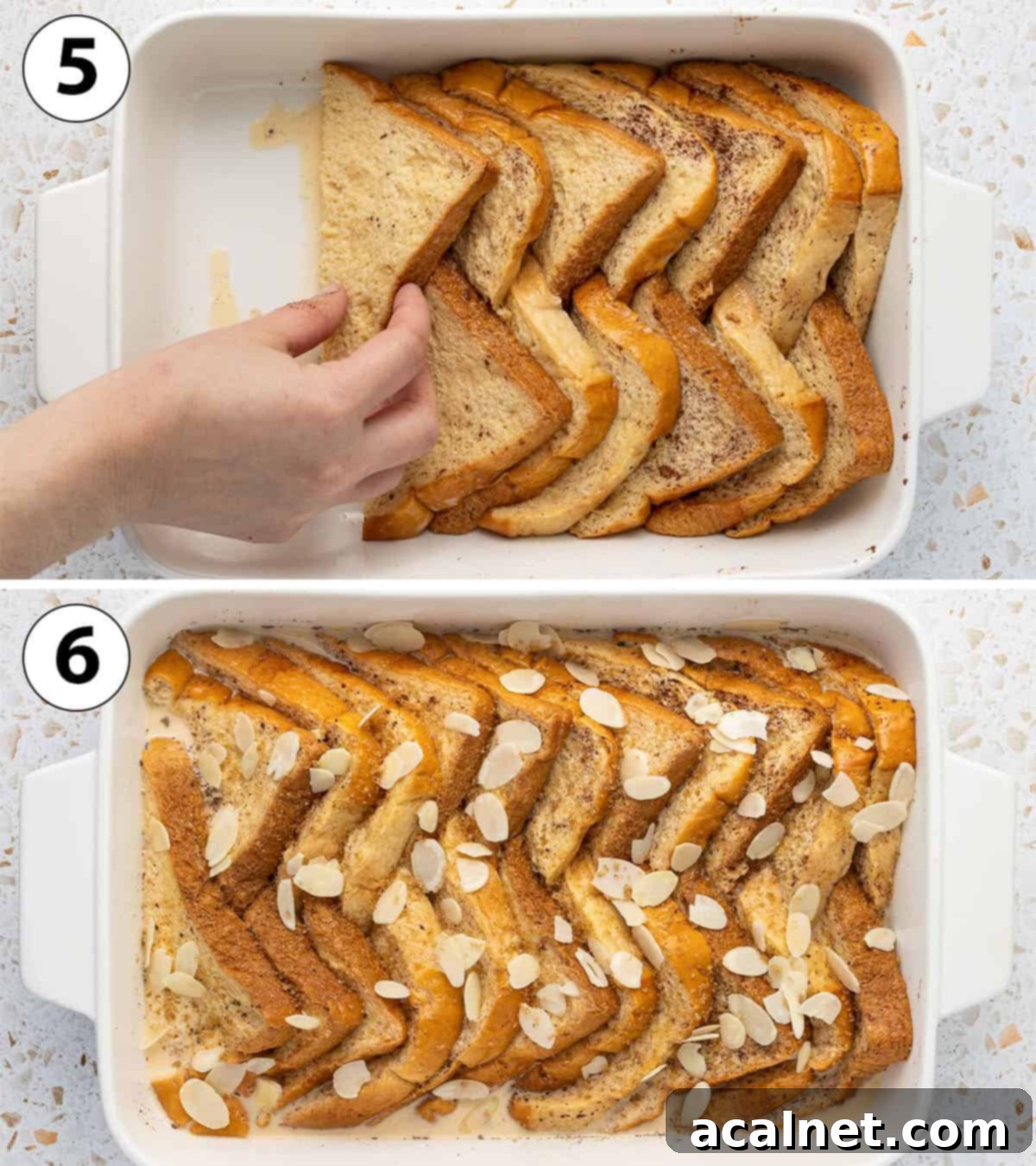
- Photo 5: Layer the Casserole: Neatly layer the soaked brioche slices inside your prepared baking dish. Arrange them with the pointy side of each triangle facing up. This arrangement not only looks beautiful but also allows for even baking. Make sure to pack the slices relatively tightly, creating a cozy bed for the custard.
- Photo 6: Pour & Soak: Pour any remaining custard base evenly over the layered brioche slices. Cover the dish (with plastic wrap or foil) and place it in the refrigerator to soak. A resting period of 30 minutes to 1 hour is ideal to allow the flavors to meld and the brioche to fully absorb the custard, ensuring a moist and flavorful interior.
- Preheat Oven: Before baking, preheat your oven to 180 degrees Celsius / 350 degrees Fahrenheit. This ensures the casserole bakes evenly and develops that perfect golden crust.
- Add Optional Toppings: Just before baking, if desired, sprinkle the top of the casserole with some flaked almonds and raw sugar (coarse sugar). These will add a delightful crunch and a beautifully caramelized finish.
- Bake to Perfection: Bake the casserole for 35 to 40 minutes. Keep an eye on it; you want the edges of the French toast bake to be wonderfully golden and crunchy, and the center to be set and custardy.
- Cool Before Serving: Once baked, remove the casserole from the oven and place it on a wire rack to cool for about 10 minutes. This allows the casserole to set slightly, making it easier to serve and preventing it from being too soft.
- Serve & Garnish: Serve your baked brioche French toast casserole warm. It’s delicious simply topped with extra maple syrup, but you can also elevate it with your choice of toppings. I personally love a dusting of icing sugar (powdered sugar) and a generous scattering of fresh blueberries and strawberries for a burst of color and freshness.
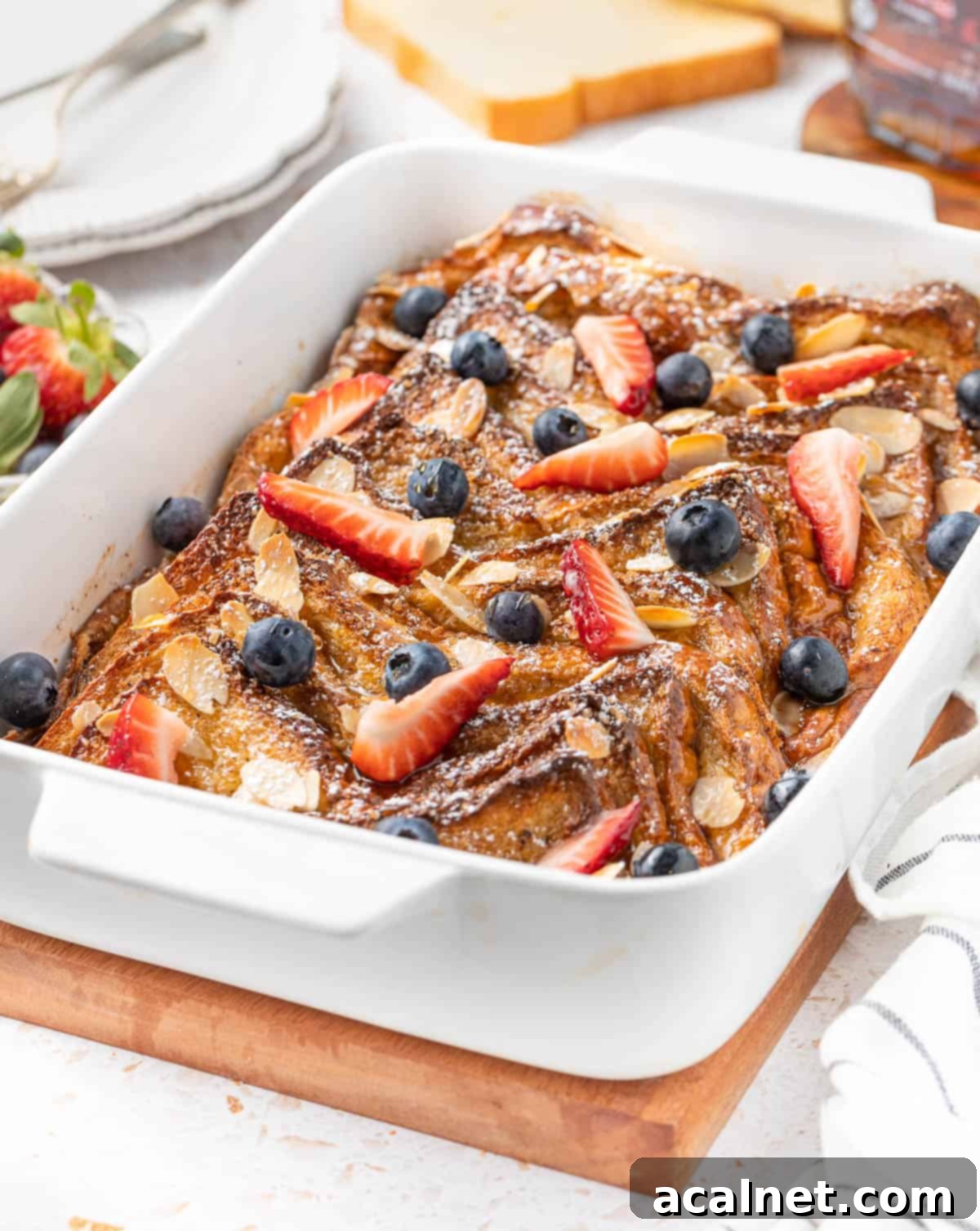
Common Questions About Brioche French Toast Casserole
For a truly similar texture and rich flavor profile, the only type of bread I highly recommend as a substitute for brioche is Challah Bread. Challah, like brioche, is an egg-rich, slightly sweet bread with a tender crumb that holds up well to soaking and baking. While other breads like challah’s less sweet counterpart, pain de mie (sandwich bread), or even sourdough can technically be used, they won’t provide the same luxurious richness or soft, melt-in-your-mouth interior that brioche offers. Avoid light, airy breads that will disintegrate, or very dense, crusty breads that won’t absorb the custard effectively.
Yes, absolutely! The tradition of French toast originated as a brilliant way to use up leftover stale bread, and for good reason. When brioche is slightly stale (day-old or even two-day-old is perfect), its structure is firmer, allowing it to absorb the custard much more effectively without becoming mushy. This leads to a superior overall texture in the baked casserole – a perfectly custardy interior with a delightful chew. While you *can* use fresh brioche bread, it tends to get much softer and can sometimes become slightly soggy once baked, lacking that ideal contrast. If you only have fresh brioche, you can lightly toast it in the oven for 10-15 minutes at a low temperature (around 120°C/250°F) to dry it out slightly before cutting and soaking.
While many casserole recipes suggest overnight soaking, I personally prefer to only let this brioche French toast casserole soak for 30 minutes to 1 hour. In my experience, brioche is quite delicate and can develop a more soggy or overly soft texture if left to soak for too long, especially overnight. The beauty of this particular recipe lies in ensuring each individual bread slice is thoroughly dipped in the custard first. This crucial step guarantees that the bread is evenly coated and saturated before chilling the casserole, allowing for a shorter, more effective soaking period that results in a perfectly custardy, not soggy, finished dish. If you absolutely need to prep it further in advance, you could assemble the casserole up to 4-6 hours ahead, but be mindful of the bread type and ensure it’s on the staler side to better withstand the prolonged soak.
The versatility of baked French toast means there are countless ways to serve and enjoy it! You can keep it classic and simple, just topped with a generous drizzle of extra Maple Syrup. For an even more indulgent treat, add a dollop of freshly Whipped Cream or a scoop of creamy Vanilla Ice Cream that will slowly melt into the warm brioche.
Beyond the basics, there are plenty of delicious topping options that can be added both before baking and fresh once the casserole is ready.
Before Baking: Consider incorporating fresh or frozen fruit (like berries or sliced peaches), chocolate chips, various chopped nuts (pecans, walnuts), or even a crunchy cinnamon streusel topping for added texture and flavor.
After Baking: Once baked, fresh toppings truly shine. In addition to maple syrup, whipped cream, or ice cream, you could add a sprinkle of Icing Sugar (Powdered Sugar), a vibrant medley of fresh berries (blueberries, raspberries, sliced strawberries), sliced bananas, a compote of your favorite fruit, or a sprinkle of toasted coconut flakes.
For this recipe, I opted for a beautiful contrast by adding some Flaked Almonds and Raw Sugar before baking, creating a lovely crunch. To serve, I brightened it up with a dusting of Icing Sugar and a colorful array of fresh berries.
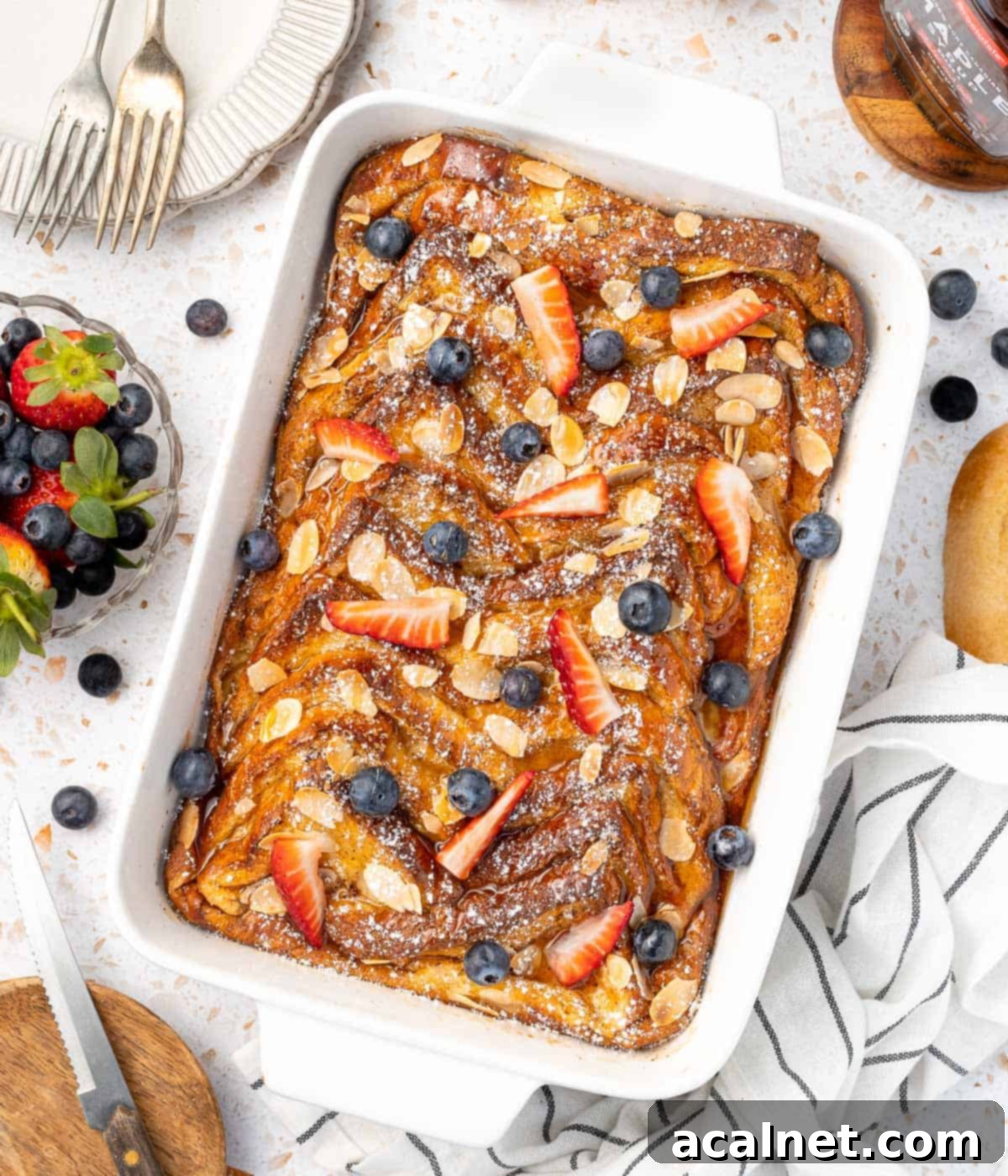
Tips for a Perfect Brioche French Toast Casserole
Achieving the perfect balance of crispy edges and a custardy interior in your Brioche French Toast Casserole is easier than you think with these expert tips:
- Embrace Stale Bread: As mentioned, using stale brioche bread is crucial for the best results. Day-old or even two-day-old brioche will absorb the custard more evenly and thoroughly without becoming soggy, leading to that delightful chewy-custardy texture in the finished dish. If your brioche is too fresh, a quick toast in the oven can help dry it out.
- Thick Slices are Key: Always cut your brioche into thick slices (at least 1.5 cm or 0.6 inches). Thin slices are prone to breaking apart when dipped in the egg mixture and can become overly soft or disintegrate during baking. Thick slices maintain their structure and provide a satisfying bite.
- Even Soaking is Essential: Don’t rush the dipping process. Ensure each brioche slice is fully submerged for a few seconds in the custard. You want it to feel heavy, indicating proper absorption. This even soaking prevents dry spots in your casserole.
- Consider Cubes for a Different Look: For a unique presentation and texture, you can cut the brioche into small cubes, approximately 2 to 2.5 cm (1-inch) wide. Place all the brioche chunks directly into the baking dish and then pour the egg mixture over them. Allow it to soak in the fridge for a few hours, occasionally flipping the cubes around to ensure every piece is evenly covered. This method creates a more uniform texture throughout.
- Don’t Overcrowd Your Dish: While you want to layer the brioche tightly, avoid excessively packing the baking dish. Leaving a little room allows the custard to bubble and caramelize around the edges, contributing to that irresistible crispy crust.
- Allow for Proper Resting Time: The 30 minutes to 1 hour of refrigeration is vital. This soaking time allows the brioche to fully absorb the liquid, ensuring a moist and flavorful interior. It’s a critical step for a successful baked French toast casserole.
- Watch for Doneness: The casserole is done when the top is golden brown and delightfully crunchy, and a knife inserted into the center comes out mostly clean. The internal temperature should reach around 77-82°C (170-180°F) for safe egg cooking, though visually checking for golden edges and a firm center is usually sufficient.
Troubleshooting Common Brioche French Toast Casserole Issues
Even the most straightforward recipes can encounter a few hiccups. Here’s how to address common issues you might face when making your Brioche French Toast Casserole:
- My French toast casserole is soggy: This is one of the most common complaints. Several factors can contribute to a soggy casserole:
- Improper Ingredient Measurement: Ensure you’ve accurately measured the ingredients for your custard base. Too much liquid relative to the bread can lead to a watery result.
- Soaking for Too Long: As discussed in the FAQs, brioche can become overly saturated. While some recipes suggest overnight, for brioche, a 30-60 minute soak after individual dipping is usually sufficient.
- Not Baking at the Right Temperature or Long Enough: An underbaked casserole will retain too much moisture. Make sure your oven is preheated correctly and bake until the top is deeply golden, crispy, and the custard is set in the center. Don’t be afraid to add another 5-10 minutes if it still seems too soft.
- Too Fresh Bread: Using extremely fresh, soft brioche can lead to sogginess. Stale bread is always preferred for better absorption and texture.
- The French toast tastes eggy: An overpowering egg flavor indicates one of two things:
- Too Many Eggs (or Extra Large Eggs): If your eggs are exceptionally large, or if you’ve added an extra one, it can skew the custard ratio. Stick to the specified size and quantity.
- Casserole Not Baked Long Enough: If the casserole hasn’t baked fully, the egg proteins might not be completely set, leading to an “eggy” taste and smell. Ensure it’s baked until golden and firm in the center. The spices and vanilla are also there to mask any potential eggy flavor, so make sure not to skimp on them.
Storing & Freezing Your Brioche French Toast Casserole
While this brioche bread French toast casserole is undeniably best enjoyed fresh, straight out of the oven, there are smart ways to manage leftovers or prepare it in advance for convenience.
Making in Advance: For stress-free entertaining, you can partially bake the dish the day before. Slightly underbake the casserole (it should be mostly set but not fully golden or crispy). Let it cool completely, then cover it tightly with plastic wrap or foil and place it in the fridge. On the day of serving, simply uncover and pop it back into a preheated oven (around 160°C/325°F) for 10 to 15 minutes, or until thoroughly heated through and the top is golden and crispy again.
Storing Leftovers: Any leftover casserole can be stored in the fridge right in its baking dish, tightly covered with plastic wrap or aluminum foil. Alternatively, for individual portions, transfer slices to an airtight container. For the best texture and flavor, aim to eat leftovers within a day, though they will safely last for up to 3 days in the refrigerator. To reheat, you can use the oven (recommended for crispiness) or even a toaster oven until warmed through and the edges are slightly crispy again. A microwave will heat it but won’t bring back the desirable texture.
Freezing: I generally do not recommend freezing this dish. The delicate, custardy texture of the brioche can become quite mushy and change significantly after thawing and reheating, often resulting in a less enjoyable experience. This dish truly shines when fresh or reheated from the fridge within a short timeframe.
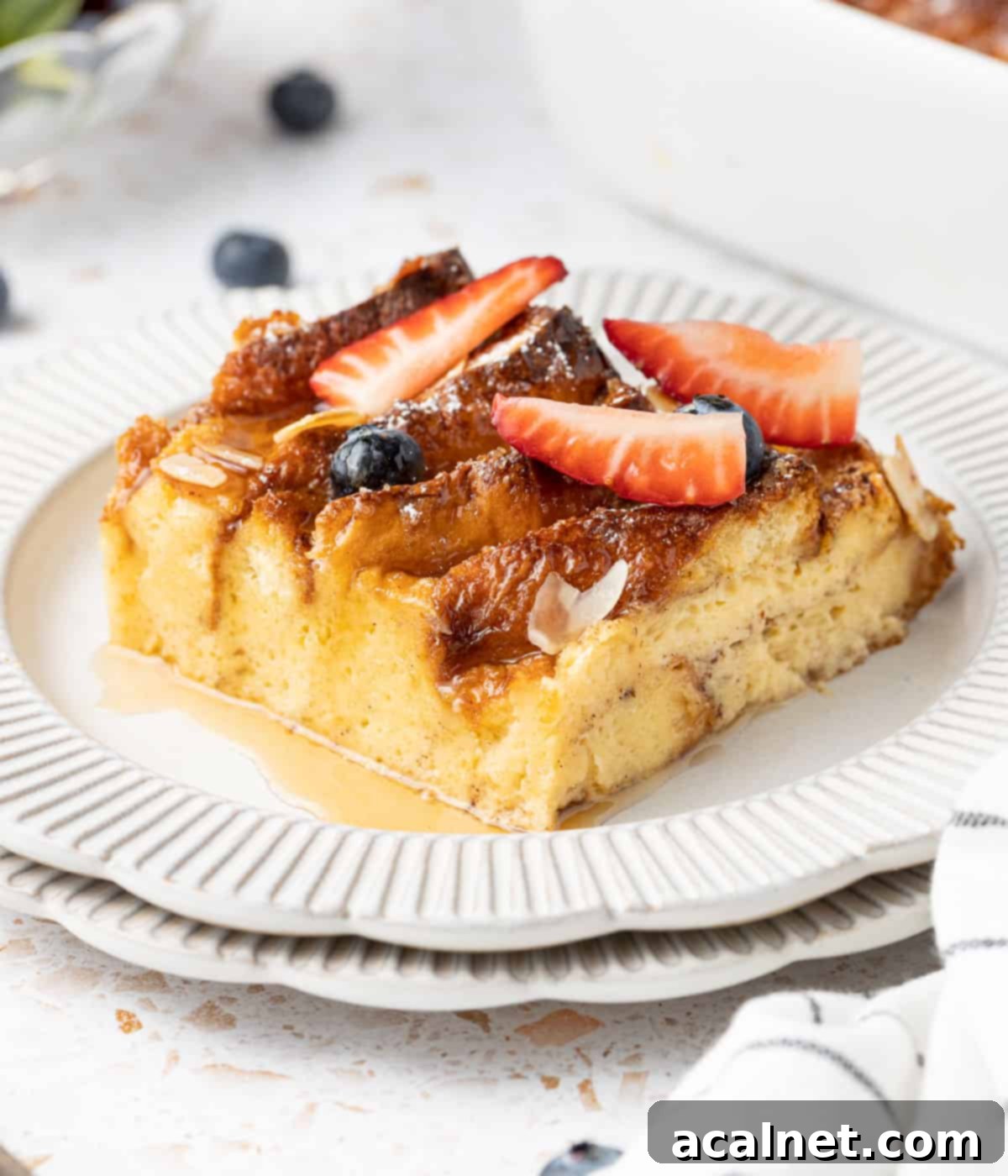
More Delicious Breakfast & Brunch Ideas
If you’ve loved this Brioche French Toast Casserole, you’ll surely enjoy exploring more of my delightful breakfast and brunch recipes. Perfect for weekends, holidays, or just a treat to start your day right!
- Fluffy & Sweet Brioche Donuts
- Healthy 3-Ingredient Banana Pancakes (Sugar-Free!)
- Irresistible Triple Chocolate Cinnamon Rolls
- Easy Cinnamon Roll Bread Loaf
- Classic Brioche Bread French Toast
- Rich Chocolate Brioche Bread
- Homemade Cinnamon Babka
- Sweet Chocolate Chip Brioche
Made this recipe?
Let us know if you liked it by leaving a comment below, and tag us on Instagram @a.baking.journey with a photo of your creation!
Recipe Card

Brioche French Toast Casserole
Print Recipe
Ingredients
- 12 slices Brioche Bread, preferably stale, thickly sliced
- 5 large Eggs
- 300 ml (1 1/4 cup) Full Cream / Whole Milk
- 180 ml (3/4 cup) Heavy / Thickened Cream
- 30 ml (2 tablespoons) Maple Syrup, or more to taste for a sweeter dish
- 1 teaspoon Vanilla Extract
- 1 teaspoon Cinnamon
- 1/4 teaspoon Nutmeg, optional
- 1/3 teaspoon Fine Table Salt
- Flaked Almond, to taste, optional
- Raw Sugar, to taste, optional
Instructions
- Lightly grease a 21 x 29 cm (8 x 11 inch) baking dish it with butter or oil.
If using a full loaf of brioche, cut it into thick slices at least 1,5 cm thick (0.6-inch).
- Cut each slice of Brioche Bread in half diagonally to get a triangle shape. Set aside.
- Prepare the custard in a large mixing bowl by whisking together the Eggs, Milk, Cream, Maple Syrup, Vanilla, Cinnamon, Nutmeg and Salt until smooth (see note 1).
- Dip each brioche slices in the custard for a few seconds, making sure they are fully covered and feel heavy (see note 2). Tightly layer the dipped slices inside the prepared baking dish, pointy side of the slice facing up. Pour any leftover the custard over the brioche slices.
- Place in the refrigerator to soak for 30 minutes to 1 hour.
- Preheat your oven on 180 degree Celsius / 350 degree Fahrenheit.
- Optionally, top the casserole with some Flaked Almond and Raw Sugar (coarse sugar) for extra crunch just before baking.
- Bake for 35 to 40 minutes or until the edges of the french toast bake are golden and crunchy. Place on a wire rack to cool down for 10 minutes before serving.
- Finish with your choice of toppings. I sprinkled the dish with Icing Sugar and served with fresh berries and a drizzle of maple syrup.
Would you like to save this recipe?
We’ll email this post to you, so you can come back to it later!
Notes
- You will notice that the cinnamon does not mix well into the wet ingredients, that’s normal.
- You will want to occasionally whisk the custard again between dipping the bread in to evenly distribute the cinnamon that will tend to float on the surface.
Nutrition (per serving)
